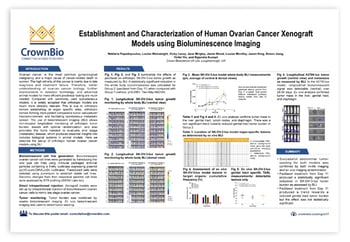- Services
- Therapeutic Areas
- Model Systems
- In Vitro
- In Vivo
- Technologies
- Service Type
- About Us
- Our Science
- Start Your Study Now
Nektaria Papadopoulou, Louise Wainwright, Vicky Lacey, Jane Wrigley, Jamie Wood, Sumanjeet Malhi, Louise Woolley, Jason King, Simon Jiang, and Rajendra Kumari
 Due to late diagnoses and common treatment failure, ovarian cancer has a high lethality, and is the major cause of cancer-related death in women. Advanced preclinical models are required to improve the understanding of ovarian cancer biology, and to make ovarian cancer drug development more efficient.
Due to late diagnoses and common treatment failure, ovarian cancer has a high lethality, and is the major cause of cancer-related death in women. Advanced preclinical models are required to improve the understanding of ovarian cancer biology, and to make ovarian cancer drug development more efficient.
It is widely accepted that orthotopic cancer models are more clinically relevant than their subcutaneous counterparts. This is due to orthotopic tumors establishing at organ specific sites, forming more patient comparable tumor vasculature/microenvironment, and facilitating spontaneous metastatic spread.
Combining orthotopic models with bioluminescent imaging (BLI) allows non-invasive longitudinal monitoring of orthotopic tumor burden, assists in optimal randomization, and also provides tools to evaluate end stage (metastatic) disease. This poster details the development and characterization of orthotopic human ovarian cancer models using BLI.
Your privacy is important to us.
We'll never share your information.
© 2024 Crown Bioscience. All Rights Reserved.


© 2024 Crown Bioscience. All Rights Reserved. Privacy Policy
2023-05-22
2021-10-28
landing_page
PDX/Databases